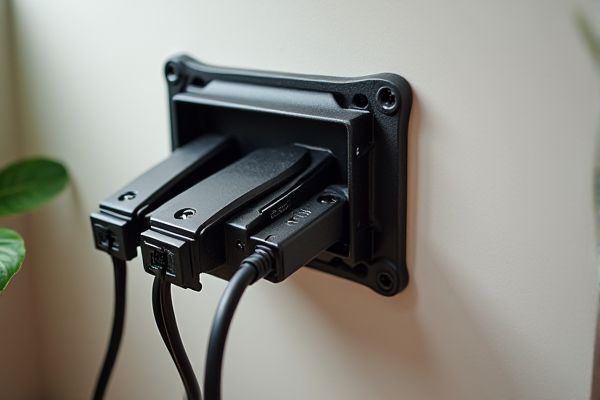
A cable management box organizes and conceals power strips and excess cords, providing a neat and safe solution for tangled cables, while a cord cover is designed to protect and hide cables running along floors or walls, preventing tripping hazards and maintaining an orderly appearance. Discover how choosing the right option can simplify Your space and enhance safety by reading the rest of the article.
Table of Comparison
| Feature | Cable Management Box | Cord Cover |
|---|---|---|
| Purpose | Encloses power strips and excess cables for organized storage | Conceals and protects cables running along walls or floors |
| Material | Plastic or metal enclosure | Flexible plastic or rubber channel |
| Use Case | Indoor, desk or floor-level cable organization | Indoor and outdoor cable routing along surfaces |
| Installation | Simple placing with lid closure | Adhesive backing or screws for mounting |
| Aesthetic | Neat, enclosed look hides clutter | Streamlined channels blend with surfaces |
| Protection | Protects from dust and accidental unplugging | Guards cables against tripping and damage |
| Size & Flexibility | Limited by box dimensions | Flexible lengths, customizable fit |
| Cost | Moderate price | Low to moderate price |
Introduction to Cable Management Solutions
Cable management boxes and cord covers serve distinct purposes in organizing and protecting electrical cords. A cable management box conceals power strips and excess cables, preventing clutter and hazards, while cord covers safely route and protect wires along floors or walls. Choosing the right solution enhances your workspace or home environment by improving safety and aesthetics.
What is a Cable Management Box?
A cable management box is a storage solution designed to neatly enclose power strips, chargers, and excess cables, preventing tangles and reducing clutter. Unlike cord covers that primarily hide cables along walls or surfaces, cable management boxes contain all wires in one compact area, improving safety and aesthetics. You can enhance your workspace or living area by using a cable management box to keep cords organized and protected from damage.
What is a Cord Cover?
A cord cover is a flexible or rigid protective sleeve designed to conceal and secure electrical cords, cables, and wires, preventing tripping hazards and creating a tidy appearance. Unlike cable management boxes that store excess cords and power strips, cord covers are typically installed along floors, walls, or baseboards to route cables seamlessly. They come in various materials, such as rubber, plastic, or fabric, offering durability while blending with interior decor.
Key Differences Between Cable Management Box and Cord Cover
A cable management box encloses power strips and excess cables, providing a clean, dust-free environment and preventing pets or children from accessing cords. In contrast, a cord cover is designed to conceal and protect cables running along floors or walls, reducing tripping hazards and improving aesthetics. Your choice depends on whether you need to store bulky power adapters or simply hide cables along surfaces for a tidier setup.
Pros and Cons of Cable Management Boxes
Cable management boxes provide an effective solution for hiding power strips and excess cables, reducing clutter and protecting cords from dust and pets. They typically offer a neat appearance and improve safety but can be bulky, limiting their use in smaller spaces or tight corners. Your choice depends on whether you prioritize comprehensive cable concealment or prefer the flexibility and slim profile of cord covers.
Pros and Cons of Cord Covers
Cord covers offer a sleek and low-profile solution to hide cables, making them ideal for managing wires along walls and floors without creating bulky clutter. They are easy to install, paintable to match your decor, and protect cords from damage or tripping hazards. However, cord covers may not conceal a large number of cables as effectively as a cable management box, and they can be less flexible when repositioning cables or devices frequently.
Aesthetic Considerations: Box vs Cover
Cable management boxes offer a sleek and concealed solution that hides power strips and excess cables entirely, enhancing room aesthetics by reducing visible clutter. Cord covers provide a more flexible and low-profile option by running cables along walls or floors, blending with surroundings but leaving cords partially visible. Choosing between a box and cover depends on the desired level of concealment and integration with interior decor.
Safety and Organization Benefits
Cable management boxes provide superior safety by enclosing power strips and excess wires, reducing tripping hazards and protecting cords from pets or children. Cord covers enhance organization by keeping cables neatly aligned along walls or floors, preventing tangling and wire damage in high-traffic areas. Choosing the right option ensures Your space remains clutter-free and safe from electrical hazards.
Choosing the Right Solution for Your Space
Selecting between a cable management box and a cord cover depends on your space's layout and cable volume. A cable management box efficiently conceals power strips and excess cable length, ideal for desk areas with multiple devices, while cord covers streamline cables along walls or floors for a cleaner pathway. Your choice ensures safer, organized wiring tailored to your environment's needs and aesthetic preferences.
Conclusion: Cable Management Box vs Cord Cover
A cable management box provides a neat, enclosed solution for hiding power strips and excess cables, reducing clutter and protecting cords from dust and pets. Cord covers offer a low-profile way to organize and secure cables along walls or floors, minimizing tripping hazards and maintaining a clean appearance. Your choice depends on whether you need to conceal bulky power adapters or simply keep cables tidy and out of the way.
 homyna.com
homyna.com